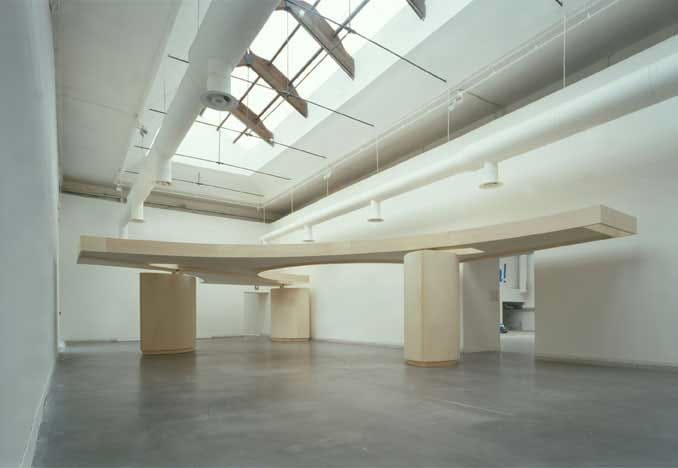Overview
This exhibition traces one of the questions to which artists return to again and again, namely the question of art's relationship to architecture: in the words of Vetruvius, the most 'public' of art forms.
The relationship might be characterized as one of productive ambivalence and playful contradiction.
Within early and late modernism, architecture has figured as a re-appearing structure: from Tatlin's 'Monument to the Third International', 1920 (architecture as propaganda), to Schwitter's 'Merzbau', 1932 (aspiration to the gesamtkunstwerk ), to Michael Asher's deconstruction of architecture (institutional critique), through to Helio Oiticica's 'Penetrables' and 'Nests' (architecture as an objective non-referential space).
The exhibition focuses on the model as object and imaginary space and comprises a range of positions from Yves Klein's radical, utopian erasure of architecture; through Dan Graham's and Karin Schneider's playfully deconstructive positions; to Eija Liisa Ahtila's, Gabriel Orozco's and Isa Genzken's appropriation of architecture as a sculptural object. The exhibition continues through to Pierre Huyghe's investigation of architecture as a social process, and finally, to Thierry de Cordier's (temporary) alignment of the artist with the architect.
CONTRADICTING ARCHITECTURE
New Work curated by Karina Daskalov
14 June– 23 July, 2005
Opening reception: Thursday 7 November, 5 – 9 pm
This exhibition traces one of the questions to which artists return to again and again, namely the question of art's relationship to architecture: in the words of Vetruvius, the most 'public' of art forms.
The relationship might be characterized as one of productive ambivalence and playful contradiction.
Within early and late modernism, architecture has figured as a re-appearing structure: from Tatlin's 'Monument to the Third International', 1920 (architecture as propaganda), to Schwitter's 'Merzbau', 1932 (aspiration to the gesamtkunstwerk ), to Michael Asher's deconstruction of architecture (institutional critique), through to Helio Oiticica's 'Penetrables' and 'Nests' (architecture as an objective non-referential space).
The exhibition focuses on the model as object and imaginary space and comprises a range of positions from Yves Klein's radical, utopian erasure of architecture; through Dan Graham's and Karin Schneider's playfully deconstructive positions; to Eija Liisa Ahtila's, Gabriel Orozco's and Isa Genzken's appropriation of architecture as a sculptural object. The exhibition continues through to Pierre Huyghe's investigation of architecture as a social process, and finally, to Thierry de Cordier's (temporary) alignment of the artist with the architect.
In the early 60's Yves Klein was obsessed with the idea of rendering architecture 'immaterial'. Using air, water and fire, he envisioned a new living environment, a new 'Eden', in which people would once again live with nature, without needing a roof or a wall. His little-known projects for fully climatised cities and walls of fire and water were carefully researched proposals on which he collaborated with architects.
Dan Graham's models 'Clinic for a Suburban Site', 1978 and "Alteration to a Suburban House" (1978) are the culmination of his reflection on the post-war suburban American house. In these, unrealizable, projects the building's interiors are exposed through a transparent sheet of glass and the back wall replaced by a mirror, which reflects not only the inhabitants, but also the outside street and the passer-by. In a parody of the elitist Modernist glass house, the American way of life is opened to scrutiny.
Karin Schneider has proposed 'A New Domestic Architecture?' in a series of functioning household objects based on landmarks of Modernist architecture. 'Suschindler House', 2001 turns Rudolph Schindler's seminal King's Road House, one of the first examples of open communal living, into a sushi-table around which visitors are invited to gather. Sake and a sushi delivery menu are provided. Schneider's work follows the tradition of Brazilian Neo-Concretism and its idea of generating objects that will 'activate' the viewer/subject through the act of interaction.
Lothar Baumgarten's 'Grammar of Construction, II [24 most used terms in Mies van der Rohe's lectures on architecture]', 1990/2005 was originally conceived for the Carnegie International in 1990 for Mies' Science Building at Pittsburgh University. Baumgarten distils the great architect's terminology and playfully turns them into verbal building blocks of terms that can also be taken to refer to scientific research at its highest level.
Gabriel Orozco's 'Shade between Rings of Air (Sombra entre aros de aire), 2003 reverses the established order/logic of the model and the finished architectural object by translating Carlo Scarpa's roofed patio/panoply, designed in 1952 for the courtyard of the Italian Pavilion in Venice, into an enlarged and abstracted 'model'.
Eija Liisa Ahtila's considers her sculptures, like the melancholic 'The Shade House' to be 'models of the mind' , structures that evoke and bring about a particular state of mind.
'Halle', 1987 one of Isa Genzken's models made out of rough chunks of concrete, condenses archetypal moments of generic Militarist architecture, evoking memories of monuments to failed ideologies.
Tacita Dean's 'Washington Cathedral', 2002 is a series of found postcards (dating from the early 20th Century) of a national monument that did not yet exist, a kind of collective imagination of an architecture yet-to-be built (the cathedral was finally consecrated in 1990).
The soon-to-be-realised 'Chapelle du Grand Rien', 2005 is Thierry de Cordier's rather atheistic project for the chapel of a psychiatric hospital in Belgium. Reduced to the simplest of formal elements - black exterior walls and 'immaculate' white walls inside - the chapel will be a quiet meditative space, devoid of any Christian iconography that will allow the elements to enter through an opening in the roof.
Pierre Huyghe's diptych of posters 'Chantier Permanent', 1993/1999 depicts an 'architecture of the incomplete', as seen particularly all over the Mediterranean, dwellings that are built without an architect by their inhabitants in their spare time. There is no fixed moment of completion, life unfolds in a work in progress, in a transitory state, very much in opposition to the traditional Western model of dwelling, conceived as a finished object and ready for purchase. In the artist's words, "what makes these structures singular is the interval between what they are and what they could potentially be, the gap between what exists and its potential."




